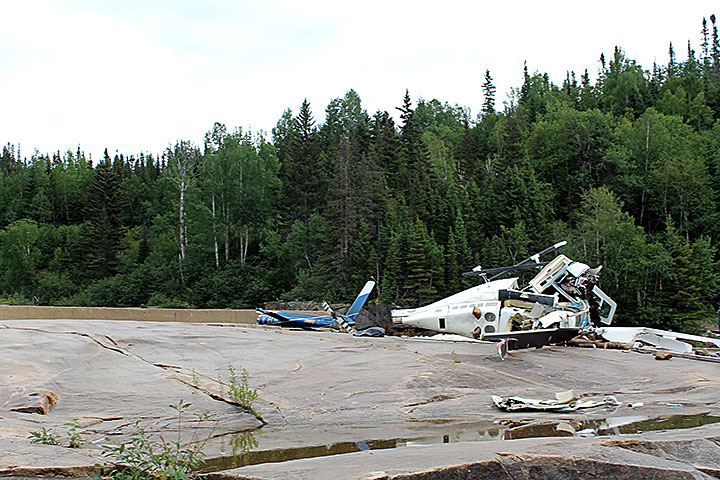Loss of directional control and collision with terrain
6442927 CANADA INC. (operating as Héli-Nord)
Bell Helicopter 206B, C-GYBK
Sept-Îles, Quebec, 20 nm N
The occurrence
On 02 September 2015, the Bell 206B helicopter (registration C-GYBK, serial number 1884) operated by Héli-Nord was flying from the airport of Sept-Îles, Quebec, with 1 pilot and 4 passengers on board. The purpose of the flight was to inspect a salmon pass approximately 20 nautical miles north of Sept-Îles. During the final approach, a few feet from the ground, the helicopter began an uncommanded rotation to the right and, after turning a few times, crashed heavily into a rock on its front right side. The accident occurred at about 0940, Eastern Daylight Time. The male passenger occupying the front left seat and the female passenger occupying the rear central seat sustained fatal injuries. The pilot and the other 2 passengers, who occupied the left and right rear seats, sustained serious injuries. The 406-MHz emergency locator transmitter activated on impact. A fire started in the engine tailpipe but was immediately extinguished by persons on site.
Media materials
News release
Loss of directional control led to September 2015 collision with terrain near Sept-Îles, Quebec
Read the news release
Deployment notice
TSB deploys a team of investigators to a fatal helicopter accident near Sept-Îles, Quebec
Dorval, Quebec, 2 September 2015 - The Transportation Safety Board of Canada (TSB) is deploying a team of investigators to the site of a fatal accident involving a Bell 206 helicopter accident near Sept-Îles, Quebec. The TSB will gather information and assess the occurrence.
Investigation information
Download high-resolution photos from the TSB Flickr page.
Class of investigation
This is a class 3 investigation. These investigations analyze a small number of safety issues, and may result in recommendations. Class 3 investigations are generally completed within 450 days. For more information, see the Policy on Occurrence Classification.
TSB investigation process
There are 3 phases to a TSB investigation
- Field phase: a team of investigators examines the occurrence site and wreckage, interviews witnesses and collects pertinent information.
- Examination and analysis phase: the TSB reviews pertinent records, tests components of the wreckage in the lab, determines the sequence of events and identifies safety deficiencies. When safety deficiencies are suspected or confirmed, the TSB advises the appropriate authority without waiting until publication of the final report.
- Report phase: a confidential draft report is approved by the Board and sent to persons and corporations who are directly concerned by the report. They then have the opportunity to dispute or correct information they believe to be incorrect. The Board considers all representations before approving the final report, which is subsequently released to the public.
For more information, see our Investigation process page.
The TSB is an independent agency that investigates air, marine, pipeline, and rail transportation occurrences. Its sole aim is the advancement of transportation safety. It is not the function of the Board to assign fault or determine civil or criminal liability.
